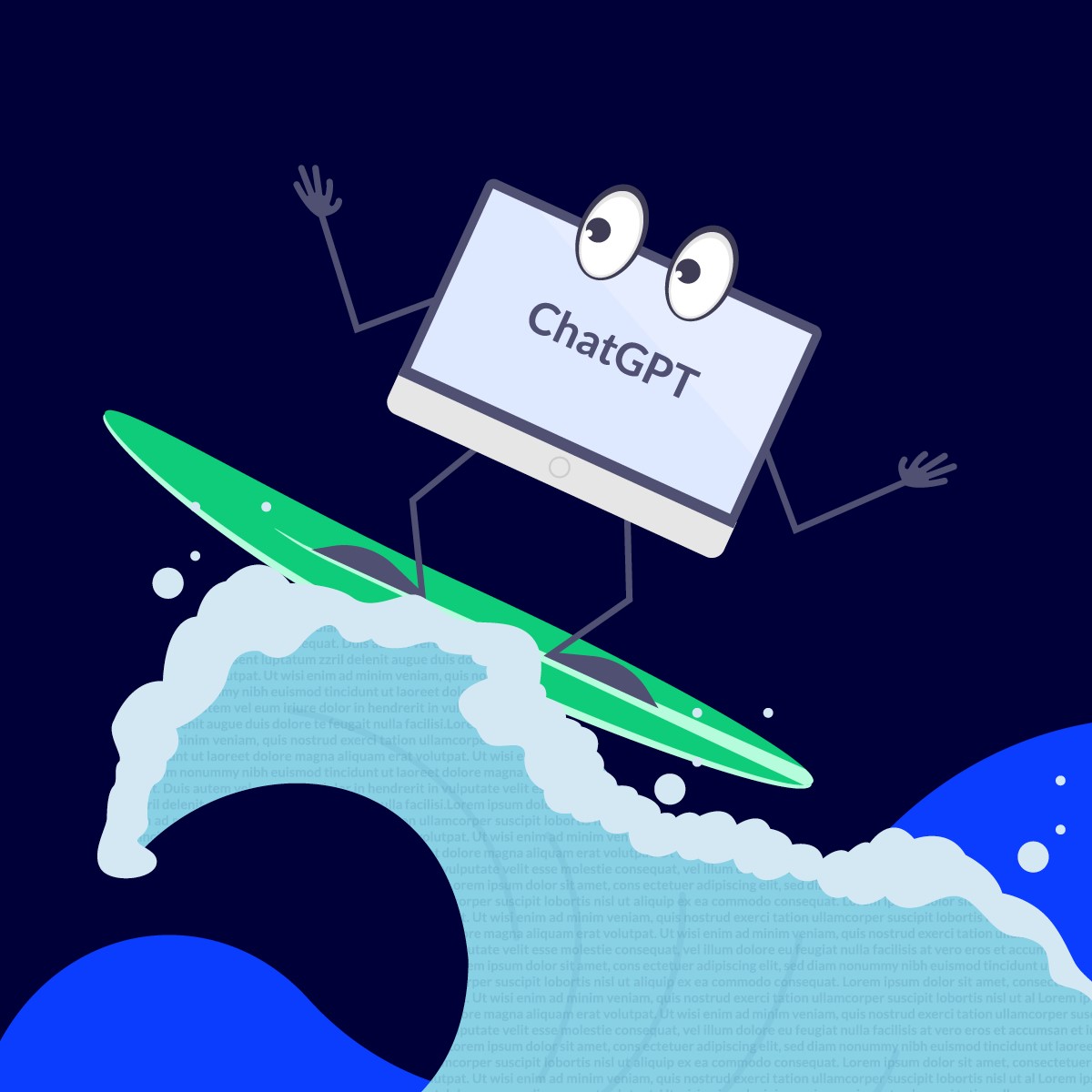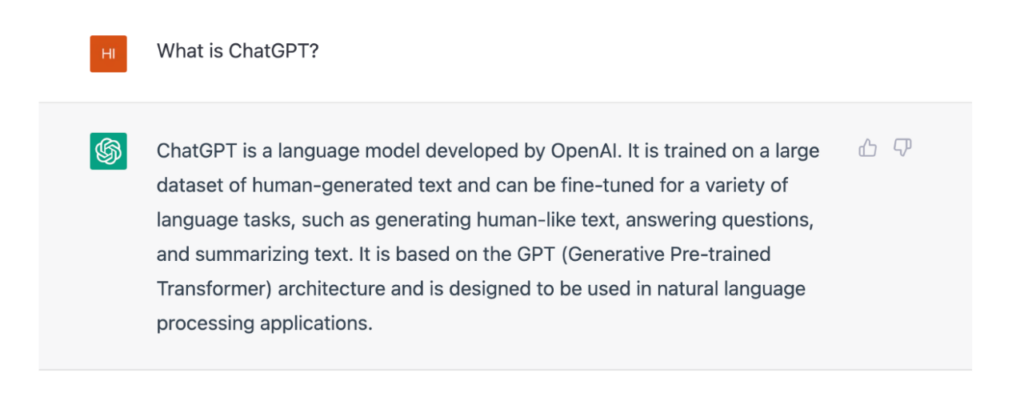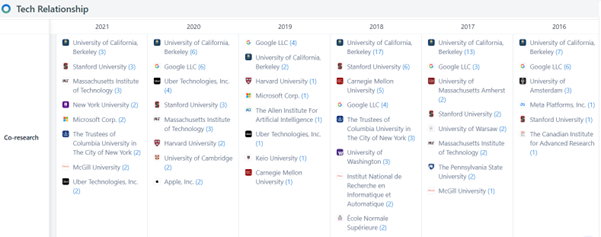
If you came across this blog by searching online, it’s likely that artificial intelligence, aka AI, is what brought you here. AI is present in many aspects of our lives — ranging from image generators to online virtual assistants, and even systems that tell farmers when to sow and reap their crops.
However, there’s a new player in the game: ChatGPT.
Developed by OpenAI, ChatGPT is an AI tool that can hold human-like conversations, admit to its mistakes, learn on the fly, correct false assumptions, and even potentially write articles like this one. It was co-founded by Elon Musk, and released in November 2022. Within three days of its launch, ChatGPT generated more than a million users.
In this article, we’ll explore what ChatGPT is and how it’s disrupting the internet.
This article was curated using our AI-powered Discovery Product, which connects billions of patent and non-patent data points. Get the technology insights and competitive intel you need.
What is ChatGPT?
To answer this question, we went to the source itself:
“ChatGPT is a language model developed by OpenAI. It is trained on a large dataset of human-generated text and can be fine-tuned for a variety of language tasks, such as generating human-like text, answering questions, and summarizing text. It is based on the GPT (Generative Pre-trained Transformer) architecture and is designed to be used in natural language processing applications.”

Simply put, you can ask ChatGPT a question or give it a task. Based on your directions, it will provide feedback, complete the task (if possible — it still has its limitations see image below), rewrite text, answer your questions and so forth.

If you aren’t happy with the results, you can always ask it to try again.
The History of Human-like Chatbots
The first chatbot ever, ELIZA, was developed by Joseph Weizenbaum, an MIT professor, in the 1960s. The program was designed to mimic human conversation and pair human input (such as questions or phrases) with a list of possible scripted responses. At the time, the program represented a massive leap forward in natural language processing (NLP) and unnatural intelligence.
Building on Weizenbaum’s model, chatbot creators aimed to create more human-like interactions. Over time, chatbots developed and advanced, eventually leading to the emergence of Web 4.0 and the ability for machines to understand context. This resulted in a widespread use of chatbots, which can now be found in various forms such as Apple’s Siri, Amazon’s Alexa, Microsoft’s Cortana, and more across various platforms including messengers, websites, and social media.
ChatGPT’s Potential
Despite significant advancements in AI technology over recent years, there are still concerns about its reliability and practicality. While AI can perform tasks like self-driving cars, it’s not infallible and can make errors. Similarly, AI can assist in disease diagnosis, but it’s not always accurate. Additionally, AI can give helpful responses to queries, but it can also provide seemingly fabricated answers. These limitations are reasons why some remain skeptical of AI’s capabilities.
Even with its limitations, many are optimistic about the future potential of AI as it continues to improve. ChatGPT, in particular, has made significant strides in the realm of content, search, and artistic AI applications, catching the attention of notable research institutions such as Stanford University, MIT, Uber, Harvard, and Meta.

Delving deeper into the ChatGPT world, we have to ask: is this model the tipping point?
From our perspective, it represents the “perfect storm” because it combines important areas of AI research: chatbots and GPT-3. By combining these technologies, ChatGPT allows users to generate human-like content and responses, and even create computer code on demand. It’s the perfect combination of cutting-edge AI advancements and could lead to exciting new possibilities.
But the disruption doesn’t stop there.
ChatGPT isn’t the only AI tool capable of performing tasks faster than humans. DALL-E, also developed by OpenAI, generates AI-created images. To provide some context on how impressive these AI images can be, one piece by a similar tool won the 2022 Colorado State Fair’s annual art competition.

Jason M. Allen created his submission for the art competition using an AI program called Midjourney, which can turn lines of text into highly realistic images. Although he used AI help, Allen still had to spend a significant amount of time fine-tuning and perfecting the piece, approximately 80 hours. Some argue that using AI in this way allows people to focus more on coming up with new ideas, rather than getting bogged down in the tedious execution process. It enables individuals to let technology handle the “grunt work” so they can focus on brainstorming and developing new concepts.
ChatGPT and DALL-E both represent huge leaps forward for NLP and image generation, but that doesn’t mean everyone is willing to welcome them with open arms. Some critics suggest that these programs represent the end of college essays and the collapse of art.
Educational Concerns
The extensive capabilities of AI chatbots, like ChatGPT, have sparked serious discussions about their potential impact on education and other related fields. The chatbot has already caused significant disruption in areas such as programming and essay writing. For example, if you ask it to write an essay on the cause of WWII, it can quickly compose a convincing term paper.
However, some school boards and education counselors are concerned that the information provided by ChatGPT to students may not be entirely accurate and that students may become too reliant on it. As a result, some schools have banned the use of the platform.
ChatGPT and Internet Searching: Mass Disruption?
There is speculation that ChatGPT could potentially disrupt the internet search industry currently dominated by Google. Microsoft recently announced it’s integrating ChatGPT’s chatbot into its search engine, Bing, to gain a competitive advantage. While Bing is significantly smaller than Google’s search engine, Microsoft has been testing ChatGPT for some time. In 2021, Microsoft invested $1 billion into OpenAI to support the development of artificial general intelligence, which includes ChatGPT.
Recently, employees of Google have reportedly raised concerns to CEO Sundar Pichai and AI Research Chief Jeff Dean about the potential threat ChatGPT poses to Google’s search engine. However, Google has been working on similar technology in its Language Model for Dialogue Applications system (LaMDA) for some time, which it’s planning to release in the coming weeks.
ChatGPT Ethical Risks and Concerns
Despite the advancements that ChatGPT and DALL-E represent in the field of AI, they also raise important risks and ethical concerns to consider, such as:
- Complexity: Large AI models involve billions, if not trillions, of data points making them impractical to train for most organizations. Additionally, they’re cost-intensive and not ecofriendly. The energy usage of the data centers required to train these models is significant, producing a significant amount of CO2 emissions. For example, training a single deep learning model can produce the equivalent carbon footprint of five cars, according to a 2019 study.
- Concentration of power: These models are built by large technology companies, with deep pockets, large R&D investments, and top talent. In the future, depending on accessibility, this may lead to significant technological imbalances.
- Potential misuse: Foundation models lower the cost of content creation, meaning it’s easier to create deepfakes that closely resemble originals. This can include anything from voice and video impersonations to fake art as well as targeted attacks. The ethical concerns involved could harm reputations or even cause political conflicts.
- Black box nature: These models still require careful training and can deliver unacceptable results due to their black-box nature. Often, it’s unclear what fact-based models are attributing responses to, which may lead to bias being introduced into the datasets.
- Intellectual property: These models are trained on a collective of created works and it’s currently unclear what the legal precedent may be for reuse of this content if it was created and delivered from the intellectual property of others.
Closing Thoughts: ChatGPT is Here to Stay
ChatGPT is a powerful and versatile chatbot with the potential to revolutionize many industries and significantly impact society. It can understand context and learn from interactions, making it valuable for a variety of applications, despite challenges and ethical concerns that need to be addressed. ChatGPT is leading the way forward in AI-powered communications.